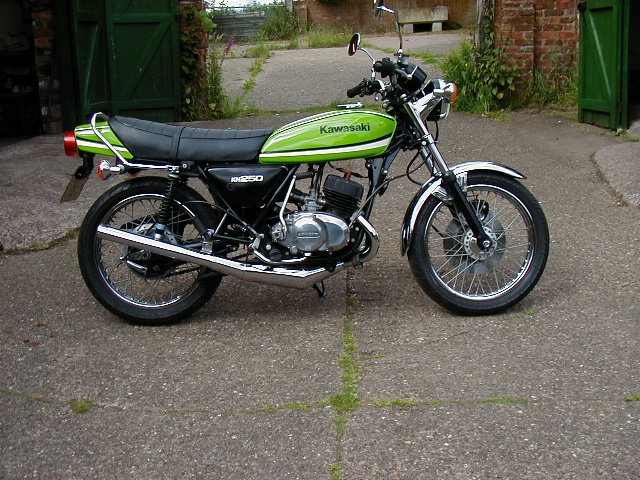
|
|
www.classicbikes.co.uk Machine of the month! L - Plate 250s. |
|
|
|
L-Plate 250s Rod
Ker time travels......
"Life was so simple for fledgling bikers
back in the 1970s. Anyone capable of walking as far as the local
No-Star dealer without tripping over his flares could buy a
motorcycle, slap on a pair of L-plates, and wobble off into the traffic".
It mattered not whether you were competent to do
so, because all those petty regulations about Compulsory Basic
Training and power limits hadn't been invented. A provisional licence
lasted for as long as you stayed alive, and the only rule was that
the bike had to have an engine of less than 250cc. Even that wasn't
much of a limitation, when you remember how similar Yamaha RD250s
were to RD350s, and Honda CB250s were to CB350s...
Going back even further, there was a time when
learners could ride bikes of any capacity, but the threat of massed
hordes of L-plated Vincents and Gold Stars terrorising the
neighbourhood probably convinced legislators that 250cc was a safer
starting point, unless a sidecar was attached. Of course, in 1958 an
average quarter-litre Beesa or Francis-Barnett would be unlikely to
clock more than about 70mph flat out, so it was only in later years
that 'Ton-Up 250s!', as the tabloid headlines used to scream, began
to be a problem.
In the Sixties there were various pretenders to the
throne of Fastest 250. Ducati produced a series of singles, some with
Desmodromic valvegear, that could creep close to the magic ton,
especially when fitted with the optional-extra tuning goodies
available. Yet these were expensive bikes, imported in tiny
quantities. For practical purposes, they didn't exist so far as Joe
Biker on the Norf Circular was concerned.
Fighting for the honour of Britain, Royal Enfield
turned out some hot 250s. Most famously, the Continental GT was a
cafe racer-styled beauty with a five-speed gearbox and some serious
power. And some serious vibration, noise and unreliability, naturally!
British bikes have their place (on a stand in a
museum, some might suggest), but if you wanted a fast 250 you really
had to have one of the new-fangled Japanese models that began to
infiltrate the market in the Sixties. Honda's high-revving Dream
twins set the pace, followed by two-strokes from Yamaha, Suzuki and Kawasaki.
Released in 1966, Suzuki's Super Six was almost
certainly the fastest ever standard 250, and certainly set the trend
for the future. Despite not quite being capable of breaking the
100mph barrier except in very favourable conditions, it effectively
had about the same performance as most old-school 500s. Faster still,
Kawasaki, a newcomer to the Blitish market, came up with a
rotary-valve twin known as the Samurai, (also available as a 350,
with speed that could humble a good 650).
Which is all very well, but forty years on most of
these early Japanese 250s are so rare that finding one for sale is
difficult. As a consequence of the way they were (ab)used, the
survival rate is pretty low, and there were never that many to start
with, in the UK, at least. It’s also worth remembering that
spares are just as tricky to find: a 1960s “rice burner”,
as they used to be called in pre-PC times, is therefore not a
practical choice.
So, those wanting an affordable, usable classic
really need to cast their attention to the next decade, a golden age
when motorcycle sales boomed and tens of thousands of new riders were
signing on the dotted line every year. Throughout the 1970s the
quarter-litre niche of the market was hotly contested by the Big
Four, and so many new 250s were hitting the roads (all too literally
in many cases) that there are still plenty left now.
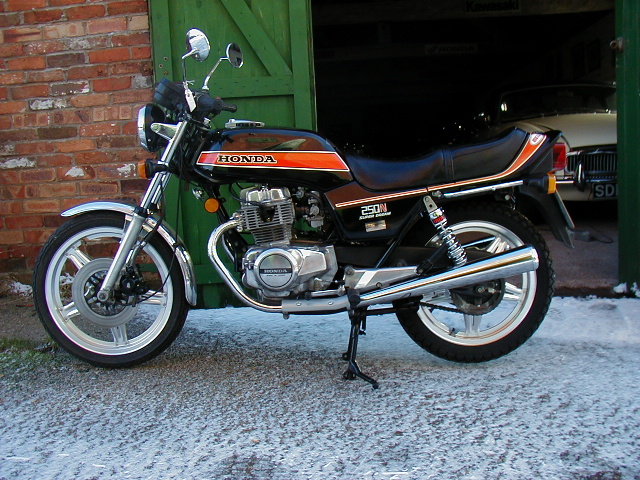 Honda
Honda began the Seventies fielding the CB250K
series, as introduced in 1968. Though of completely different design
to the original Dreams, these were still ohc four-stroke twins, with
all the advantages and disadvantages inherent to the breed. Revving
to 10,000rpm to produce around 30bhp gave Honda-style motorcycling a
completely different flavour to the opposition, which were 100%
two-stroke in the lower capacity classes for the moment.
The CB250K, and its much rarer CB350K big brother
(which actually displaced only 325cc, incidentally) had reached K2
designation by the turn of the decade. Give or take a few stripes on
the petrol tank, the main difference by this stage was that a
significant amount of performance had been lost, as seemed to happen
to all Hondas of the era.
The 5-speed, 2ls drum brake Ks gave way to the
6-speed, disc brake CB250G5 in 1974 (again, there was a big brother
CB360 - this time with a capacity that almost matched its model
number). The press were consistently unkind to the G5, saying that it
was painfully slow and handled badly. As 80mph was about the max
unless you rode over Beachy Head, it's hard to argue with the first
part, but I reckon the handling problems were grossly overstated, and
no-one seemed to mention that a G5 would go twice as far on a gallon
of juice as the two-stroke opposition.
Honda made half-hearted attempts to make their
bikes more sporty in the mid-Seventies. For L-platers this resulted
in the CB250G5 turning into the CJ250. Not an impressive update,
this! Apart from a styleless tank and kinked 2-1 exhaust, the main
difference was that the electric start had been removed, thus making
it less convenient for typical customers (or their Dads who were
signing the HP form?) who wanted economy and convenience.
Luckily the CJ didn't have to last long before the
all-new CB250T Dreams arrived in 1977. Using 3-valve per cylinder
technology pioneered by the car division, the engines were ultra
short-stroke 360 degree twins with balance shafts. At the expense of
much whirring, performance was up on the old models, with somewhere
over 85mph being possible if you had the time to spare.
Dreams may have looked dumpy, but they were
genuinely innovative elsewhere, boasting a stressed spine frame,
Comstar wheels with low-profile tyres, electronic ignition and
superior suspension. Well, it was for a while, but the FVQ rear
dampers weren't nicknamed “Fade Very Quickly” for nothing!
The Dream turned into the altogether more desirable
SuperDream in 1979. The engine had gained another gear and mods to
prevent oil leaks (yes, on a Honda) and cure (maybe) a few top-end
problems. But the big news was the integrated “Euro”
styling, as also seen on the big CB900 four. Though the basic chassis
was similar, subtle changes in the riding position made the handling
even better, a fact that miserable magazine roadtesters tried hard
not to admit!
Tens of thousands of SuperDreams were sold in a
couple of years before the new 125cc limit for learners was brought
in, so obviously there are quite a few left. Not as many as you might
think, though, because many were cannibalised for spares and scrapped
when 250s fell out of fashion and prices hit rock bottom in the '80s.
Kawasaki
Continuing in alphabetical order brings us to
Kawasaki, the Green Meanie people. At the beginning of the decade the
Samurai was still on sale. Well, it was in theory, but without a
properly organised UK dealer network, you probably couldn’t have
found one very easily.
The same goes for the first examples of the S1
triple, its replacement. Kawasaki’s objective in those days was
simply to build the fastest bikes possible, hence the H1 500,
announced in 1969. The 250 was merely a scaled-down version of the
same thing: three carburettors feeding three hungry cylinders,
sending a cloud of blue smoke and pollution through three chrome silencers.
Early S1s looked slightly quaint, but they
certainly went well. Limited by low gearing, a ton wasn’t quite
possible, but just feel the noise, to quote contemporary popular beat
combo, Slade. Definitely an appreciating asset for the future. Moving
through S1B and S1C models, the smallest triple stuck with a front
drum brake longer than the rest, but developed its unique style. The
exhausts now pointed skywards, while the tanks looked altogether
smoother, with a broad stripe carried over onto the seat tailpiece,
which was a trend-setting feature in itself in those days.
Unfortunately, the threat of emissions control
regulations spelled doom for smelly two-strokes. Kawasaki was
therefore busily engaged in designing a new range of clean machines,
spearheaded by the Z400 twin and Z650 four. No 250cc version for the
moment, though (perhaps because the American market had never
bothered with anything under about 350cc), so in the meantime the S1
was toned down and turned into the KH250. Still basically the same
under the skin, making the engine quieter had sapped power, so
performance was down. As there was no particular gain in economy (not
that anyone would care!), the only good news was the uprated chassis,
which finally ditched the front drum in favour of a disc. The bad
news, as per the norm then, was that it didn’t work properly in
the rain. Still, it’s the thought that counts.
While the KH struggled on into the next decade,
Kawasaki also managed to get new 250cc four-strokes onto the market
before the 125 limit came into force. These really belong in a story
about the next generation, but the road bike was imaginatively called
the Z250. It was notable for being smaller and lighter than other
quarter-litre twins, but the engine did have a habit of exploding.
Honda
Honda began the Seventies fielding the CB250K
series, as introduced in 1968. Though of completely different design
to the original Dreams, these were still ohc four-stroke twins, with
all the advantages and disadvantages inherent to the breed. Revving
to 10,000rpm to produce around 30bhp gave Honda-style motorcycling a
completely different flavour to the opposition, which were 100%
two-stroke in the lower capacity classes for the moment.
The CB250K, and its much rarer CB350K big brother
(which actually displaced only 325cc, incidentally) had reached K2
designation by the turn of the decade. Give or take a few stripes on
the petrol tank, the main difference by this stage was that a
significant amount of performance had been lost, as seemed to happen
to all Hondas of the era.
The 5-speed, 2ls drum brake Ks gave way to the
6-speed, disc brake CB250G5 in 1974 (again, there was a big brother
CB360 - this time with a capacity that almost matched its model
number). The press were consistently unkind to the G5, saying that it
was painfully slow and handled badly. As 80mph was about the max
unless you rode over Beachy Head, it's hard to argue with the first
part, but I reckon the handling problems were grossly overstated, and
no-one seemed to mention that a G5 would go twice as far on a gallon
of juice as the two-stroke opposition.
Honda made half-hearted attempts to make their
bikes more sporty in the mid-Seventies. For L-platers this resulted
in the CB250G5 turning into the CJ250. Not an impressive update,
this! Apart from a styleless tank and kinked 2-1 exhaust, the main
difference was that the electric start had been removed, thus making
it less convenient for typical customers (or their Dads who were
signing the HP form?) who wanted economy and convenience.
Luckily the CJ didn't have to last long before the
all-new CB250T Dreams arrived in 1977. Using 3-valve per cylinder
technology pioneered by the car division, the engines were ultra
short-stroke 360 degree twins with balance shafts. At the expense of
much whirring, performance was up on the old models, with somewhere
over 85mph being possible if you had the time to spare.
Dreams may have looked dumpy, but they were
genuinely innovative elsewhere, boasting a stressed spine frame,
Comstar wheels with low-profile tyres, electronic ignition and
superior suspension. Well, it was for a while, but the FVQ rear
dampers weren't nicknamed “Fade Very Quickly” for nothing!
The Dream turned into the altogether more desirable
SuperDream in 1979. The engine had gained another gear and mods to
prevent oil leaks (yes, on a Honda) and cure (maybe) a few top-end
problems. But the big news was the integrated “Euro”
styling, as also seen on the big CB900 four. Though the basic chassis
was similar, subtle changes in the riding position made the handling
even better, a fact that miserable magazine roadtesters tried hard
not to admit!
Tens of thousands of SuperDreams were sold in a
couple of years before the new 125cc limit for learners was brought
in, so obviously there are quite a few left. Not as many as you might
think, though, because many were cannibalised for spares and scrapped
when 250s fell out of fashion and prices hit rock bottom in the '80s.
Kawasaki
Continuing in alphabetical order brings us to
Kawasaki, the Green Meanie people. At the beginning of the decade the
Samurai was still on sale. Well, it was in theory, but without a
properly organised UK dealer network, you probably couldn’t have
found one very easily.
The same goes for the first examples of the S1
triple, its replacement. Kawasaki’s objective in those days was
simply to build the fastest bikes possible, hence the H1 500,
announced in 1969. The 250 was merely a scaled-down version of the
same thing: three carburettors feeding three hungry cylinders,
sending a cloud of blue smoke and pollution through three chrome silencers.
Early S1s looked slightly quaint, but they
certainly went well. Limited by low gearing, a ton wasn’t quite
possible, but just feel the noise, to quote contemporary popular beat
combo, Slade. Definitely an appreciating asset for the future. Moving
through S1B and S1C models, the smallest triple stuck with a front
drum brake longer than the rest, but developed its unique style. The
exhausts now pointed skywards, while the tanks looked altogether
smoother, with a broad stripe carried over onto the seat tailpiece,
which was a trend-setting feature in itself in those days.
Unfortunately, the threat of emissions control
regulations spelled doom for smelly two-strokes. Kawasaki was
therefore busily engaged in designing a new range of clean machines,
spearheaded by the Z400 twin and Z650 four. No 250cc version for the
moment, though (perhaps because the American market had never
bothered with anything under about 350cc), so in the meantime the S1
was toned down and turned into the KH250. Still basically the same
under the skin, making the engine quieter had sapped power, so
performance was down. As there was no particular gain in economy (not
that anyone would care!), the only good news was the uprated chassis,
which finally ditched the front drum in favour of a disc. The bad
news, as per the norm then, was that it didn’t work properly in
the rain. Still, it’s the thought that counts.
While the KH struggled on into the next decade,
Kawasaki also managed to get new 250cc four-strokes onto the market
before the 125 limit came into force. These really belong in a story
about the next generation, but the road bike was imaginatively called
the Z250. It was notable for being smaller and lighter than other
quarter-litre twins, but the engine did have a habit of exploding.
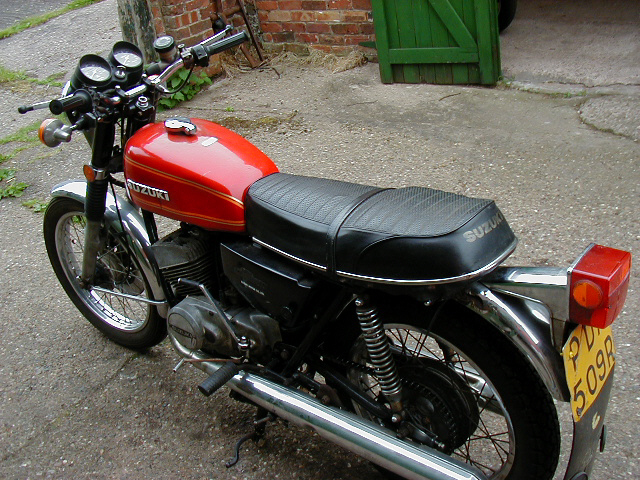 Suzuki
Having shocked everyone with the Super Six,
Suzuki’s line of twins continued with the T250. In common with
the rest of the range, these turned into the GT, complete with front
disc brake&ldots; and a new secret weapon. Yes, Ram Air had arrived!
Don’t get too excited, though, because Ram Air was really
nothing more than a bit of extra alloy bolted to the cylinder heads,
not the mild supercharging effect we are familiar with nowadays. The
idea was simply that when the bike was moving air would be rammed
into the crucial area around the heads. Errm, brilliant concept, lads.
Indeed, you might suggest that the only benefit of
the alloy appendages was to reduce fin ring, making the GT250
unusually quiet and refined for a two-stroke. On the debit side,
extracting spark plugs was made more difficult and not everyone liked
the look of the engine.
Give or take a few stripes, GTs remained much the
same through the usual series of J/K/L/M updates, although there was
a suspicion reflected in road test figures that less power was available.
Then something strange happened. After a period in
which most bikes had been getting slower, Suzuki introduced a new
model that was actually more powerful that the old one! Tending to
prove that Ram Air was all hot air, the GT250A didn’t have
anything tacked onto its cylinder heads. But it definitely went
faster, thanks to various internal tweaks, so Yamaha’s RD250
finally had some competition.
The final flourish for the twins was the completely
redesigned GT250X7, introduced in 1978. Although the engine probably
produced less power than the outgoing model’s, the big change
here was the chassis, which was much smaller and lighter. As the
general trend for two-wheelers was in the opposite direction (think
of the Yamaha XS1100, Kawasaki Z1300 and Suzuki GS1000!), this was a
very brave move. The proof of the pudding was in the riding, and the
X7 suddenly made the Yamaha RD250 feel stodgy and overweight.
Like Kawasaki, Suzuki’s allegiance to strokers
was threatened by legislation, resulting in the appearance of a new
range of clean-living four-strokes. Fortunately for Honda, the GS400
dohc twin never had a 250cc smaller brother, and L-platers were
largely unaffected by the 1981 arrival of the GSX250, thanks to the
125 rule.
Suzuki
Having shocked everyone with the Super Six,
Suzuki’s line of twins continued with the T250. In common with
the rest of the range, these turned into the GT, complete with front
disc brake&ldots; and a new secret weapon. Yes, Ram Air had arrived!
Don’t get too excited, though, because Ram Air was really
nothing more than a bit of extra alloy bolted to the cylinder heads,
not the mild supercharging effect we are familiar with nowadays. The
idea was simply that when the bike was moving air would be rammed
into the crucial area around the heads. Errm, brilliant concept, lads.
Indeed, you might suggest that the only benefit of
the alloy appendages was to reduce fin ring, making the GT250
unusually quiet and refined for a two-stroke. On the debit side,
extracting spark plugs was made more difficult and not everyone liked
the look of the engine.
Give or take a few stripes, GTs remained much the
same through the usual series of J/K/L/M updates, although there was
a suspicion reflected in road test figures that less power was available.
Then something strange happened. After a period in
which most bikes had been getting slower, Suzuki introduced a new
model that was actually more powerful that the old one! Tending to
prove that Ram Air was all hot air, the GT250A didn’t have
anything tacked onto its cylinder heads. But it definitely went
faster, thanks to various internal tweaks, so Yamaha’s RD250
finally had some competition.
The final flourish for the twins was the completely
redesigned GT250X7, introduced in 1978. Although the engine probably
produced less power than the outgoing model’s, the big change
here was the chassis, which was much smaller and lighter. As the
general trend for two-wheelers was in the opposite direction (think
of the Yamaha XS1100, Kawasaki Z1300 and Suzuki GS1000!), this was a
very brave move. The proof of the pudding was in the riding, and the
X7 suddenly made the Yamaha RD250 feel stodgy and overweight.
Like Kawasaki, Suzuki’s allegiance to strokers
was threatened by legislation, resulting in the appearance of a new
range of clean-living four-strokes. Fortunately for Honda, the GS400
dohc twin never had a 250cc smaller brother, and L-platers were
largely unaffected by the 1981 arrival of the GSX250, thanks to the
125 rule.
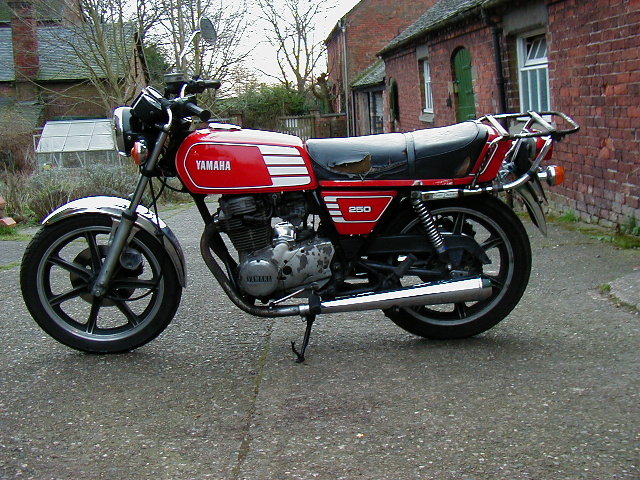 Yamaha
Interestingly, Yamaha's earliest 250cc twins,
starting with the 1959 YDS1, were sold more on luxury than
performance. The image changed drastically in later years as a direct
result of racing success. By 1970 the series had reached the DS7
mark, featuring a completely redesigned engine with
horizontally-split crankcases that went on to form the basis of all
the company’s quarter-litre twins, spawning the even more potent
liquid-cooled offshoots.
The giant-killing range of R(ace)D(eveloped) twins
arrived in 1973. Basically similar to the DS7, the main novelty was
reed valve induction, which helped cram a bit more mixture into the
cylinders. As always, the idea was to increase power and speed, but
the difference could be felt in the way the engine responded all
through the range, which made the RD250 easier to ride on the odd
occasions when a crazed seventeen year-old wasn’t going flat
out. For some reason early RDs had a six-speed gearbox with top
blanked off, which caused no end of problems&ldots; especially if you
tried to add the extra ratio simply by removing the bit of selector
that prevented the mechanism from going all the way round to first.
On the chassis side, the big news was a front disc
brake, based on the Girling pattern, rather than the inferior
swinging type used by Honda on the G5. The Yamaha needed better
brakes, of course, because it was at least 10mph faster. Blessed with
speed, handling (by wobbly mid-1970s’ standards) and reliability
(by fragile two-stroke standards!), it was inevitable that the RD250
became a racetrack favourite. Starting grids bulged with them, some
bikes virtually unmodified, many wearing “spannies” and
breathed on by tuning aces like Stan Stephens.
Suzuki’s decision to inject a bit of pep back
into the GT250 saw Yamaha respond with a new-look RD in 1976. The
rounded tank had gone in favour of the angular “coffin”
style and the engine was black. It looked meaner, even if it
wasn’t really. Alloy wheels also arrived on the scene, optional
at first but most people wanted them and paid the price. Less evident
except to true RD anoraks were improved suspension, but less
effective sliding calliper brakes (disc at both ends by this stage).
Possibly the biggest advance was completely invisible –
electronic ignition, which finally put an end to the chore of
contact-breaker and timing adjustment.
To digress slightly, Yamaha did something
uncharacteristically boring in 1978 by launching the XS250 and its
360cc double. A simple sohc twin very much in the Honda CB mould, its
only virtue was fuel economy. Stay awake and you could get 80mpg. If
the engine lasted that long. Overall, not a spectacular success.
Moving swiftly on, by 1978 the RD250 was as fast as
ever, more reliable and better looking. Unfortunately for Yamaha,
Suzuki had just released the GT250X7, which was at least as fast, and
cheaper. It was also much lighter, and generally had all the
qualities that people bought RDs for, only more so.
Yamaha lost plenty of sales as a result, but not
for long. In 1980 the RD250LC arrived, packed with racetrack
technology and looking like nothing else. 35bhp was the claim, which
should have been plenty to crack the ton, although roadtest figures
tended to be a bit disappointing in this respect. Never mind,
liquid-cooling allowed a higher state of tune with less threat of
meltdown, so there was plenty more power waiting to be unleashed by
the skilled - and plenty to be lost by the unskilled, as ever!
Yamaha
Interestingly, Yamaha's earliest 250cc twins,
starting with the 1959 YDS1, were sold more on luxury than
performance. The image changed drastically in later years as a direct
result of racing success. By 1970 the series had reached the DS7
mark, featuring a completely redesigned engine with
horizontally-split crankcases that went on to form the basis of all
the company’s quarter-litre twins, spawning the even more potent
liquid-cooled offshoots.
The giant-killing range of R(ace)D(eveloped) twins
arrived in 1973. Basically similar to the DS7, the main novelty was
reed valve induction, which helped cram a bit more mixture into the
cylinders. As always, the idea was to increase power and speed, but
the difference could be felt in the way the engine responded all
through the range, which made the RD250 easier to ride on the odd
occasions when a crazed seventeen year-old wasn’t going flat
out. For some reason early RDs had a six-speed gearbox with top
blanked off, which caused no end of problems&ldots; especially if you
tried to add the extra ratio simply by removing the bit of selector
that prevented the mechanism from going all the way round to first.
On the chassis side, the big news was a front disc
brake, based on the Girling pattern, rather than the inferior
swinging type used by Honda on the G5. The Yamaha needed better
brakes, of course, because it was at least 10mph faster. Blessed with
speed, handling (by wobbly mid-1970s’ standards) and reliability
(by fragile two-stroke standards!), it was inevitable that the RD250
became a racetrack favourite. Starting grids bulged with them, some
bikes virtually unmodified, many wearing “spannies” and
breathed on by tuning aces like Stan Stephens.
Suzuki’s decision to inject a bit of pep back
into the GT250 saw Yamaha respond with a new-look RD in 1976. The
rounded tank had gone in favour of the angular “coffin”
style and the engine was black. It looked meaner, even if it
wasn’t really. Alloy wheels also arrived on the scene, optional
at first but most people wanted them and paid the price. Less evident
except to true RD anoraks were improved suspension, but less
effective sliding calliper brakes (disc at both ends by this stage).
Possibly the biggest advance was completely invisible –
electronic ignition, which finally put an end to the chore of
contact-breaker and timing adjustment.
To digress slightly, Yamaha did something
uncharacteristically boring in 1978 by launching the XS250 and its
360cc double. A simple sohc twin very much in the Honda CB mould, its
only virtue was fuel economy. Stay awake and you could get 80mpg. If
the engine lasted that long. Overall, not a spectacular success.
Moving swiftly on, by 1978 the RD250 was as fast as
ever, more reliable and better looking. Unfortunately for Yamaha,
Suzuki had just released the GT250X7, which was at least as fast, and
cheaper. It was also much lighter, and generally had all the
qualities that people bought RDs for, only more so.
Yamaha lost plenty of sales as a result, but not
for long. In 1980 the RD250LC arrived, packed with racetrack
technology and looking like nothing else. 35bhp was the claim, which
should have been plenty to crack the ton, although roadtest figures
tended to be a bit disappointing in this respect. Never mind,
liquid-cooling allowed a higher state of tune with less threat of
meltdown, so there was plenty more power waiting to be unleashed by
the skilled - and plenty to be lost by the unskilled, as ever!
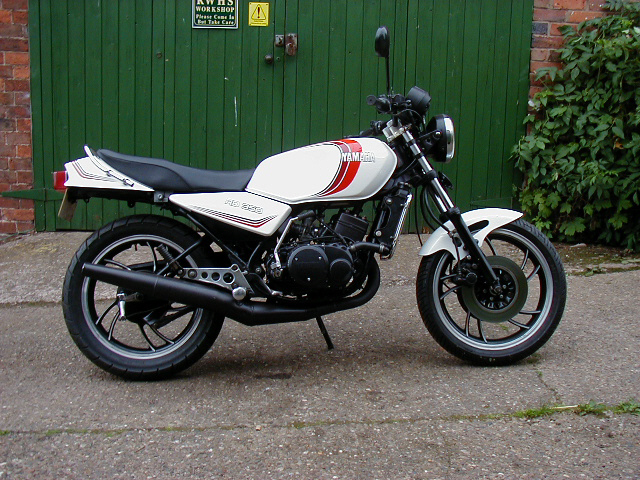 The LC sold by the thousand and rapidly achieved
cult status. The question now is: where have all the Elsies gone?
Crashed/blown up/stolen, is the answer. In its heyday, this model,
particularly the 350cc version, had a life expectancy of about three
months if you were lucky. Consequently, good condition standard bikes
are a rarity. Thanks to the spoilsport 125 limit, learners were soon
excluded from the Elsie fellowship, but it was fun while it lasted.
Which just about sums up the whole era.
By Rod Ker, October. 2004.
The LC sold by the thousand and rapidly achieved
cult status. The question now is: where have all the Elsies gone?
Crashed/blown up/stolen, is the answer. In its heyday, this model,
particularly the 350cc version, had a life expectancy of about three
months if you were lucky. Consequently, good condition standard bikes
are a rarity. Thanks to the spoilsport 125 limit, learners were soon
excluded from the Elsie fellowship, but it was fun while it lasted.
Which just about sums up the whole era.
By Rod Ker, October. 2004. |
|
Did you enjoy reading this? Please
e-mail us your views to rod@classicbikes.co.uk
INDEX & LINKS to other articles (for more of the same); - Kawasaki Z1-Z900 "Kawasaki's ‘New York Steak’ prototypes disguised as Honda CB750s were plying the roads of America by 1971, clocking up big mileages to make sure that everything was right first time. - Class of '76: Laverda Jota v Kawasaki Z900 - Kawasaki 500 Triples. "If Hannibal Lecter practised dentistry, this is the sort of noise that would be coming from his surgery"! - L-Plate 250s "Life was so simple for fledgling bikers back in the 1970s. Anyone capable of walking as far as the local No-Star dealer without tripping over his flares could buy a motorcycle, slap on a pair of L-plates, and wobble off into the traffic". - Honda CBX1000 "If you don't know what a Phantom jet fighter sounds like, buy a Honda CBX and have a fiddle with the exhaust system"! |